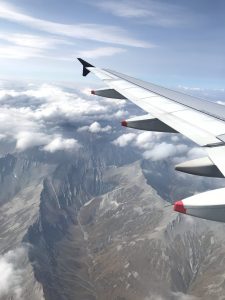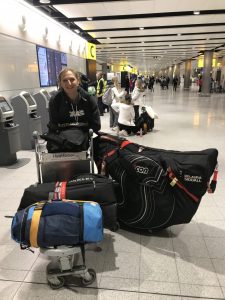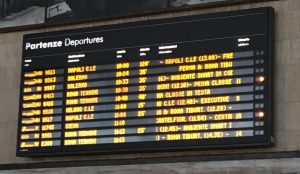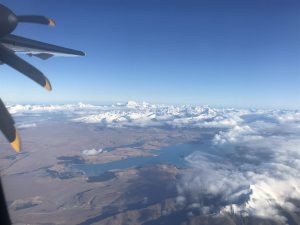The Northern Hemisphere season has kicked off and with an amazing smorgasbord of races to choose from across Europe and the USA, I thought I’d give some more tips around travel, that I’ve picked up on over the past few years of travelling the world training and racing.

As most of you may know, I live a pretty nomadic lifestyle travelling the world as I train and race. It’s pretty awesome, getting to live, train and race in some amazing places around the globe. Different cultures, and languages, so many incredible experiences and opportunities. However, travelling can also be stressful and tiresome and expensive as we have bikes and bags to transport to these amazing locations.
Last year, I visited around 13 countries, 30 different airports and caught countless flights, trains, buses, taxis and hire cars to attend various races. One of the best things about this sport is the opportunity to travel to some incredible locations and destinations to train and race, but this travel can also be one of the most stressful parts of our sport as well.

I have put together some of my top T R A V E L T I P S below to hopefully help make your next experience a little less stressful.
T – TIMEZONES
When travelling, get on the destination time zone as soon as you can, this helps with the adjustment. Adjust your sleeping to the destination. This can be hard to try to sleep, when you are wide awake due to the time zone of where you left. But even just closing your eyes and relaxing and trying to sleep will help. Alternatively try to stay awake as long as you can if that matches the time zone you are travelling too.
It can be a good idea to travel with an eye mask to help you block out the light and perhaps a sleeping aid tablet. I also always put my headphones on, even if not listening to anything, and the noise cancelling ones are worth the investment I think.
On arrival, try to match the time straight away, don’t nap in in the day, just try to carry on and then perhaps crash out early at night and sleep through. (You could always take a sleeping tablet in case.) If you get chance on arrival, a great way to help the body clock switch time zones, is to get out for an easy, swim, bike or run. This isn’t a training session as such it’s about flushing the body of the travel and getting it moving and adjusting to the new day.

R – RELAX & REST
Relax, you are travelling, a lot of things when you travel are out of control, and there’s very little you can do with it. So deep breathes, count to ten and just go with the flow. A little bit like when you race, control the controllables, and just manage the unknowns.
Use the enforced sitting time to catch up on the rest and recovery you need. Sleep and just enjoy resting. Or maybe try some meditation or breathing exercises.
Also, I recommend noise cancelling headphones. It just cuts out that murmur whether you want to sleep or not. I often just put headphones on regardless of whether I’m listening to anything or watching anything. It just helps me switch off and relax.
A – ACTIVATION
Whilst it’s good time to rest and relax, it’s also good to balance this with some activation work. Make sure you get up every now and again and walk about to get the body moving and blood flowing. Some simple calf raises and ankle flexing will help. Shoulders rotations and some stretches to keep the shoulders and back open. Also, neck stretches and twists too. Use the toilet breaks as good opportunities for activation.
V – VOLUME
That’s volume of water to drink… also referred to as hydration (but it didn’t start with a V). Flying dehydrates you so ensure you keep your fluids up whilst travelling. Consider taking a few electrolyte tablets to help with the hydration (my choice Shotz) Avoid caffeine if you are trying to sleep, or if you are drinking it (or even wine) just make sure you are matching it with water.
E – EXERCISE
On arrival, a good way to help adapt to the time zone, is to do some exercise. It doesn’t need to be much and shouldn’t be a big training session, but just try to get out to go for a walk, or easy run. Perhaps put your bike together and check it’s all working by going for an easy spin and turn of the legs, or a swim. Don’t worry about not feeling great, you’ll likely feel sluggish and not great, but it’s about moving the body and helps to flush the travel from you, as well as adapt you to the new time zones.
L – LOYALTY
Try to build up loyalty with one airline or a group of airlines. This builds your status with the airline and can lead to better flight deals, seat options, check in services and of course baggage allowances.

T – TIGHTS
That’s tights being compression tights! I always travel wearing my compression tights, particularly for long haul flights. I really find it helps. So, consider grabbing a pair of compression tights or even compression socks and wearing these whilst travelling. (My go to are my Skins RY400 leggings.)
Another supporting aid I’ve found is using recovery boots on arrival, to help again with any swelling from the travel. My go to is my Air Relax Recovery boots.
I – IMMUNE SYSTEM
Flying (or travel) brings you into all kinds of contact with different people and potential germs and virus. I always carry DoTERRA On Guard, that I spray around the edge of my faithful travel hoodie. I also have Paracetomol, Strepsils, hand sanitizer, mouth wash, sleeping tablets with me.
P – PEE BREAKS
As in life, pee breaks are a good sign, it means you are hydrated. During your working day, a pee break is a good way to also ensure you are getting up and away from your desk, and keeping the body moving. Studies have shown that regular short breaks are actually more efficient in our working and allow us to then have good focused periods of concentration and work. Consider it a little like interval training in triathlon. When travelling pee breaks have again a double function, ensuring you are hydrated (V is for Volume) and also providing a little activation (A is for Activation)
S – SNACKS
Check in advance if you get a meal or snacks on your flight, but also as athletes, it’s also good to take some of your own healthy food and snacks along. The food provided by the airline may not be your choice or the best option. Good idea to buy food before you get on the flight too, and even before you get to the airport if possible, as it’s likely to be the cheaper option
Watch out for Part 2 of my travel tips – all about luggage and packing!
Sid x
Don’t Die Wondering
Twitter: @lmsiddall
Instagram: @lmsid
Facebook: facebook.com/LauraSiddallTriathlete/



